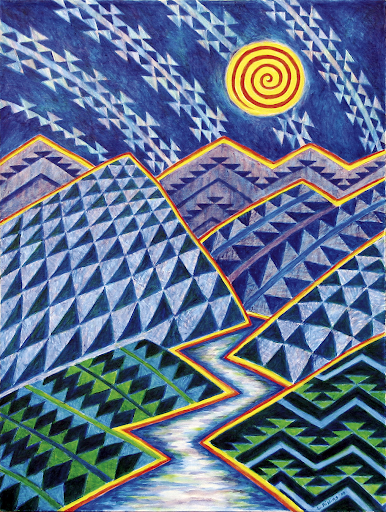Overview
Spirit of the Land: Exploring Layered Landscapes Through Native Basket Designs

Author:
Maggie Peters, Yurok/Karuk Educator, Traditional Basket Weaver, Cultural Preservationist, Native American Studies Model Curriculum Learning Specialist at Humboldt County Office of Education
Lizzy Dostal, Arts Learning Specialist Humboldt County Office of Education
Lyn Risling, Karuk/Yurok/Hupa Artist, Author, Illustrator, Ceremonial Leader
Lisa Morehead-Hillman, Karuk/Yurok/Shasta, Basketweaver and Educator
Video, shot & directed by Michelle Hernandez and Richie Wenzler
Video support provided by Joanna Galicha, Graphics & Communications Specialist at Humboldt County Office of Education
Grade(s): 6-8
Suggested Amount of Time: Four 45-55 minute Sessions
Curriculum Themes
- History
- Cultural Strengths
- Law/Government
- Relationship to Place
- Cross Curricular Integration
Learning Goals
Observe, interpret, and critically engage with art using reflective techniques such as "Notice, Wonder, Feel" while exploring symbolism in Indigenous art.
Understand and appreciate the cultural significance of basket weaving for Northern California Tribes.
Recognize the importance of cultural identity in Indigenous communities, with an emphasis on how art preserves traditions, expresses worldview, and empowers resilience.
Explore the role of artists as cultural leaders, using art to advocate for social change and cultural survival.
Create a mixed media artwork inspired by Lyn Risling.
Lesson Overview
In this interdisciplinary art and cultural studies unit, students will explore the heritage, resilience, and artistic traditions of Indigenous peoples from northwestern California through the lens of contemporary Native artist, Lyn Risling. The unit begins with an exploration of Risling’s painting Ithívthaneen Achip (Center of the World), a vibrant visual landscape that reflects a deep connection to the spirit of the land through traditional basket designs. Using the "Notice, Wonder, Feel" strategy, students will examine the emotional and symbolic depth of the artwork, considering the theme of connection between land and identity.
Students will view a short film and read a biography about Risling’s life and artistic journey, gaining a deeper understanding of how her work embodies Indigenous values, history, and spiritual relationships to place. Partner activities will support students in synthesizing this information and appreciating how Risling’s art contributes to cultural continuity. The unit also includes visual studies of traditional Northern California basketry, integrating the short book, Weaving Our Stories by Lisa Morehead-Hillman and the film, The Weavers of Northern California to explore the cultural significance of basket making. Students will learn the names, functions, and symbolism of traditional designs and consider how basketry expresses Indigenous identity, creativity, and resistance.
In the culminating project, students will create a multimedia landscape artwork inspired by Risling’s composition, incorporating traditional basket patterns and natural elements to express their own connections to land, identity, and community. By engaging with Indigenous art, history, and lived experience, this unit supports empathy, critical thinking, and respect for Native perspectives. It invites students to see art as self-expression and a powerful tool for creating belonging, cultural resilience, and honoring Native peoples in California.
Teacher Background
Northern California Native basketry is a living tradition that reflects an Indigenous community’s deep, intergenerational relationship with the land. Each basket reflects cultural knowledge, artistic skill and spiritual and ecological understanding of place. The practice of basket weaving depends on sustainable access to ancestral lands, where plants like willow, beargrass, ferns, and hazel are tenured through cultural burning practices and gathered with intention. These lands and the traditional stewardship practices needed to maintain them were severely disrupted by colonization, forced removal, environmental destruction, and policies of assimilation and genocide. As a result, the continuity of these intricate traditions is endangered. Few master weavers remain, and the knowledge is at risk of being lost due to access to master weavers, access to land, and the immense time and labor required to be a committed weaver.
Renowned artist Lyn Risling, a member of the Karuk, Yurok, and Hupa communities of northwestern California, has carried these cultural and aesthetic traditions into her artwork for decades. Her paintings reflect the strength, beauty, and resilience of Indigenous cultures, often incorporating basket designs as visual language—symbols that carry spiritual, cultural, and historical meaning. Risling’s work is rooted in a worldview that honors the land as sacred and interconnected with all aspects of life. Her art bridges traditional and contemporary forms, celebrating cultural continuity while also challenging narratives of erasure. In particular, she uses the patterns found in Northern California basketry to express deeper messages of identity, resistance, and relationship to place.
As students engage in this unit, they will come to understand Native basketry not just as an art form, but as a reflection of cultural survival and belonging. They will learn how Indigenous art and artists like Lyn Risling carry forward traditions that have endured despite colonial violence and erasure. It’s vital that students approach these lessons with empathy, respect, and a willingness to unlearn harmful narratives. Through this work, they will be invited to see themselves as people who can support Native artists and communities—by learning, advocating, and contributing to the preservation of Indigenous cultural practices.

